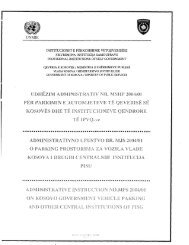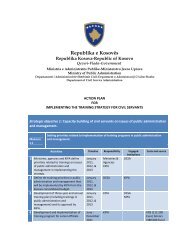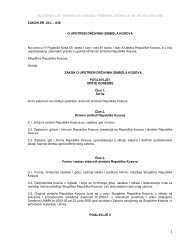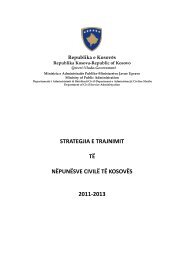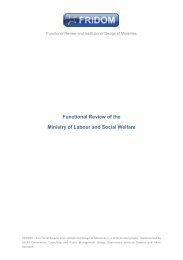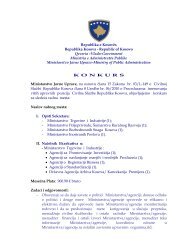Download
Download
Download
You also want an ePaper? Increase the reach of your titles
YUMPU automatically turns print PDFs into web optimized ePapers that Google loves.
to its priorities. A suggestion was made that a certain % of the budget should be ring fenced for the health<br />
sector.<br />
The MOF noted that the MOH prepared a good budget bid and that the MOF forwarded its proposals for<br />
consideration to the government rather than rejecting them, so it appears that the decision not to fund the<br />
proposals was made at the political level. To strengthen the MOH‟s arguments for a larger share of the<br />
expenditure in future budgets it could present information on the trend in expenditure on health compared<br />
to other areas as a % of GDP, as a % of the State budget and in comparison to other countries. The draft<br />
Health Sector Strategy lacks this analysis and leaves the MOH in a weak position to argue its case for<br />
increased funding.<br />
Ring fencing budget shares for a sector is often argued against as poor practice in public finances as it<br />
prevents a full consideration of relative priorities between sectors, particularly as the ring fencing if adopted<br />
for one sector can spread to ring fencing for other sectors. Some countries have operated poverty<br />
reduction ring fencing for some sectors and as a result have neglected investment in other areas that<br />
promoted economic growth, such as infrastructure investment. There can be other problems with ring<br />
fencing, for example in Vietnam the rings fencing of 20% of the budget for education caused problems for<br />
provinces with rapidly growing revenues that they were unable to apply effectively to education and<br />
prevented them from investing in other priority areas. It was also difficult to apply the ring fencing through<br />
the local government and central government spending as local governments had some autonomy over<br />
expenditure and did not always spend the amount of the transfer from central government calculated for a<br />
sector on that particular sector. Any proposal for ring fencing should consider these and other issues.<br />
A more effective approach would be to present well justified proposals for expenditure including the<br />
analysis of the budget shares and to demonstrate results from the use of the budget funds.<br />
Changing the use of funds during the year from the appropriations in the budget<br />
The comment was made that it can be difficult to fund emerging priorities during the year and to move<br />
expenditure.<br />
While the Public Finance Law has reasonably generous virement provisions, in practice they can be<br />
laborious to implement as the budget is executed at a detailed level. There are four larger groups of<br />
expenditure: capital, salaries and wages, goods and service and other recurrent expenditure, with more<br />
detailed categories below these classifications such as types of utility expenditures. This arrangement for<br />
the budget is common when countries are focused on control of expenditure and cash management. As<br />
budget systems evolve, larger classifications of expenditure are used and greater flexibilities are provided<br />
to budget organisations to move expenditures, but these flexibilities are accompanied by increased<br />
accountability for performance and greater internal financial management controls. Taking this stage of<br />
evolution into account, the MOH could explore options to accelerate their flexibilities to manage funds by<br />
offering to pilot aspects of performance based budgeting which is commonly accompanied by greater<br />
flexibilities in the management of resources, in return for greater demonstration of service and financial<br />
performance. The suggestions relating to the statement of service performance and the use of service<br />
agreements discussed in this appendix in relation to hospitals are examples of some elements of<br />
performance based budgeting that can be used to support an argument for greater flexibility in the use of<br />
resources.<br />
Revenue earned by institutions are not fully returned to institutions<br />
The comment was made that the arrangement of concluding an MOU each year with the MOF on the<br />
percentage of earned revenues to be allocated to the health sector is an unnecessary process as the<br />
revenues should be 100% allocated to the institutions. This would improve the incentives to collect the<br />
revenue and provide resources for projects to improve services and working conditions.<br />
The MOH could develop a policy proposal to government to support this proposition for the health sector.<br />
The proposal could set out:<br />
Description of the issues with the current arrangements<br />
Proposal for change and description of benefits of the change. The MOH may wish to present<br />
various options such as retention of revenue for some institutions only rather than all institutions<br />
particularly if there are particular risks with conflicts of interest as with regulatory and licensing<br />
50



